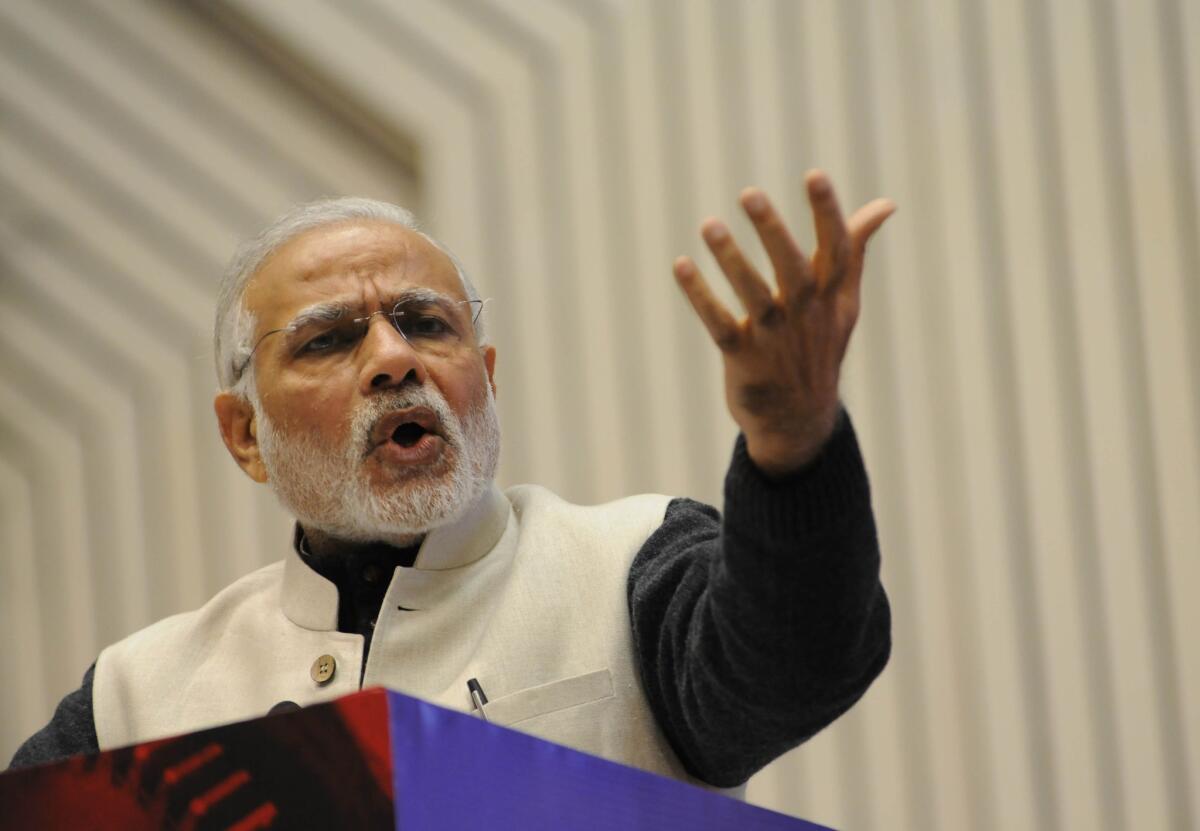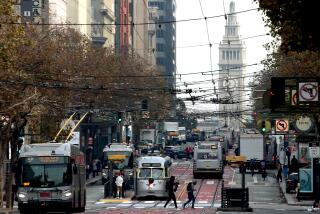Can U.S. businesses help India’s chaotic cities become ‘smart’?

Indian Prime Minister Narendra Modi speaks Jan. 16 during an event to launch an initiative to bolster start-ups.
Among his many ambitious ideas, Indian Prime Minister Narendra Modi wants to modernize his country’s pell-mell cities and improve its sometimes frosty ties with the United States.
Modi’s plan to build 100 “smart cities” nationwide brings the initiatives together, with the goal of using technology from the U.S. and around the world to improve the quality of life and environmental sustainability in India’s chronically underplanned urban areas.
Join the conversation on Facebook >>
President Obama pledged his support when he visited India a year ago, and this week a delegation of U.S. officials and businesses is traveling through the country to promote American expertise and products for Modi’s multibillion-dollar plan. U.S. experts are helping to create the master plan for one of the proposed smart cities, the port of Visakhapatnam, and providing technical support for two others.
But there remain lingering questions about Modi’s smart cities program, including lack of clarity from the government on what makes a city “smart” and whether India will be able to sweep aside the bureaucratic and infrastructure challenges that have long vexed foreign investors.
“Greater U.S. private sector investment will depend on addressing the persistent business challenges,” Bruce Andrews, deputy commerce secretary, told a news conference Wednesday in Mumbai, India’s commercial capital.
“U.S. companies and investors around the world need markets with clear [public-private partnership] structures, predictable environmental regulations and strong intellectual property protections. Progress has been made … but more can be done.”
That has been a familiar refrain for U.S. investors for years. Although India began liberalizing its economy a generation ago, foreign investment remains low, particularly in major infrastructure projects. In certain sectors, India requires foreign companies to partner with domestic ones and source large proportions of their goods locally, which critics say has inhibited innovation and development.
Hundreds of major infrastructure projects nationwide have stalled or been abandoned. On the whole, despite some showpiece airports and a better transnational highway system, India remains saddled with outdated and insufficient infrastructure and its cities are struggling to keep up with a massive influx of people.
A McKinsey Global Institute report recently projected that India’s urban population would soar from 340 million in 2008 to 590 million by 2030. India’s major cities suffer from a lack of urban planning, as was made clear this month when a massive and largely unmonitored trash dump outside Mumbai, home to some 15 million people, caught fire and spread a blanket of acrid smog across the city for several days.
Modi, who took office in May 2014 with a mandate to boost economic growth, has promised to ease obstacles to modernization. In December, a government-appointed panel of experts recommended sweeping changes in how public-private partnerships are devised and regulated.
Modi’s central government has earmarked $7 billion for the smart cities program and called on cities to compete for grants by developing proposals based around providing 24-hour water and electrical supplies, state-of-the-art transportation and education systems, emphasizing solar energy and other environmentally sustainable solutions and mobile applications to promote efficient government.
Critics dismiss the plans as vague and designed to benefit corporations, and worry the government will build islands of prosperity in the midst of the tremendous poverty that engulfs Indian cities.
“They run the risk of becoming enclaves of privilege, with private sector representatives already advocating the exclusion of the poor and marginalized through high prices and policing,” Ayona Datta, a lecturer at the University of Leeds in Britain wrote in a recent op-ed.
Leaders of U.S. companies that traveled to India, representatives of 18 U.S. companies were included in the delegation, say the project presents significant opportunities to sell water purification systems, wireless technology, “smart” electricity meters and other products to help cities provide better amenities. The Obama administration has been pushing for ways to expand exports to India, which have already tripled in the last decade to $37.2 billion annually.
“We will not have realized the full potential of our relationship if we do not tackle lingering challenges, particularly in India’s business climate,” Andrews said.
The companies in the delegation traveling with Andrews included Torrance-based S2 Global Inc., which provides security scanning systems for airports and other major transportation hubs. President Ajay Mehra has done business in India before, recently selling security scanning software for the metro system in the capital, New Delhi, but said the mood surrounding the smart cities project was particularly optimistic.
“I see a lot of excitement, and we’re hearing all the right things from the government,” said Mehra, “but time will tell.”
Follow @SBengali on Twitter for more news from South Asia
More to Read
Start your day right
Sign up for Essential California for news, features and recommendations from the L.A. Times and beyond in your inbox six days a week.
You may occasionally receive promotional content from the Los Angeles Times.







